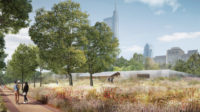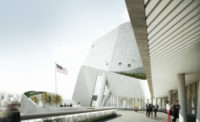The future of Auschwitz is a topic that would scare most architects away. But Russell Thomsen and Eric Kahn, partners in the Los Angeles firm IDEA, were drawn to the subject of how the concentration camp in southern Poland will be experienced by future generations. During visits to Auschwitz and nearby Birkenau, a 400-acre “annex” built expressly for extermination, they realized that, if the camp is to be maintained as a historic site, it will someday need to be rebuilt. But how long can the rebuilding process continue? The architects asked themselves if there are ways that Birkenau—effectively the largest Jewish cemetery in the world—can remain relevant without being turned into a museum or a static memorial.
In an exhibition at SCI-Arc’s library gallery titled Thinking the Future of Auschwitz, through November 30, Thomsen and Kahn suggest that it might be best to wall off Birkenau. The barrier they propose would preclude future restoration and at the same time turn the site into a Tel Olam, the Biblical term for a place of unspeakable evil, a place that must be rendered inaccessible (literally “a heap forever”). They developed a plan to gather logs from every country in Europe from which Jews were sent to Birkenau; the logs would then be stacked to form a wall around the site. Of course, over time the new wall would deteriorate, raising the question, once again, of whether to rebuild.
Earlier this month, Eric Owen Moss, the director of SCI-Arc, conversed with Thomsen in the school’s library gallery, which was filled to bursting. “We were thinking maybe no one would show up,” joked Moss, “and we wouldn’t have to do this.” But then he launched into a discussion that touched on art, music, and literature (including a prose poem on the Holocaust by his father, who wrote as Moss Herbert), and eventually focused on practical questions about the Birkenau proposal: How tall would the barrier be? Would visitors climb on it, the way they climb on Peter Eisenman’s Holocaust memorial in Berlin?
Kahn died in June, which left Thomsen not only to answer Moss’s questions, but also to create the exhibition, with the support of the Graham Foundation. Accompanying the moving renderings is an installation that, he said, “isn’t a model of the proposal but is in the spirit of the proposal”—a structure shaped like the perimeter of Birkenau, enclosing a space that can’t be seen or entered. In this case, the wall is covered with shredded paper, suggesting bits of logs and recalling the Nazis’ meticulous record-keeping. If the installation seems inscrutable, that’s okay with its creators. The proposal, Thomsen said, “is not about providing explanation” but rather “is meant to withhold solace and prevent convenient closure.”







